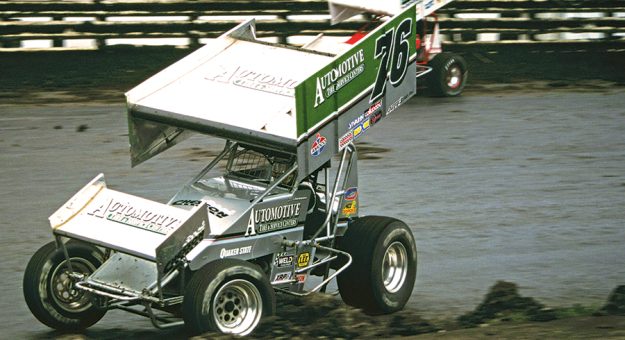The Chesson brothers were made up of P.J. and James. It was 1999 when the two green and silver cars began on the World of Outlaws trail.
The Chesson brothers were made up of P.J. and James. It was 1999 when the two matching green and silver cars began showing up on the World of Outlaws trail, and they immediately began making an impression on the winged 410 sprint car world.
P.J drove the No. 76, carrying the family number, while James (his younger brother by roughly two years) drove the No. 22 in homage to his favorite sprint car racer, Jac Haudenschild.
The two brothers‘ personalities couldn‘t be more different. P.J. was notoriously — almost infamously — outspoken and always prepared for action, while James was quiet and could even be described as shy.
Both of the boys from New Jersey showed talent, and seemed to be on a path to lifelong racing careers. But, just a few short years later both were out of racing, headed on very different life paths.
So, whatever happened to P.J. and James? To tell their story we must go back to the beginning, and the story of their racing careers begins with their father, Peter Chesson.
Sadly, on Sunday, April 11, Pete succumbed to COVID-19 at age 74.
Prior to the birth of his four children, Pete Chesson had already made his mark in auto racing. He started out driving drag cars in 1963, and won a national championship in the Pro Stock division in 1969 before transitioning to big block dirt modifieds.

After a few attempts at driving on dirt, with unimpressive results, he pivoted to the role of car owner. Chesson‘s modifieds carried the No. 76, and his drivers were some of the best in the D.I.R.T. ranks. Northeast Dirt Modified Hall of Famers Brett Hearn, Billy Pauch and Stan Ploski all drove for Pete, frequently finding victory lane.
Chesson embraced innovation, finding ways to improve his cars to give his drivers an edge. He was also a successful businessman, with a school bus operation servicing local school districts.
He would later expand his resume, adding commercial real estate, high-end car washes, and automotive repair. In short, he had the financial means to fund a successful race team in the era prior to corporate sponsorship.
Naturally, the four children — daughter Lizzy and sons P.J., James, and Tim — accompanied their parents to race events as small children to watch their father‘s car compete. However, none were struck with the fever to climb behind the wheel themselves. Instead, the three boys developed a passion for motocross.
After an injury, youngest son Tim quit racing, and today runs a chain of luxury race-themed car washes created by his father, called Gus & Bucky‘s. Lizzy, who P.J. describes as “a badass,” was never involved in racing, but is today the longtime Managing Director for the United States Equestrian Federation show jumping department.
In 1997, both P.J. and James won national motocross championships in their respective classes.
“Dad went off the deep end then,” P.J. recalled with a laugh. “He bought like 12 chassis and built six cars for each of us, we had 10 motors … he went all in.”
For a hauler, Chesson contacted Sammy Swindell.
“The first trailer we bought, Dad bought it from Sammy along with, ‘Hey, would you be willing to work with the boys to help them drive these things?‘ P.J. remembered.
At the time, the Outlaws legend was racing less, preparing to wind down his driving in order to concentrate on helping his son Kevin further his own budding racing career. Swindell agreed to take on the role of mentor to the Chesson boys and was quickly getting them up to speed.
“When you get to know Sammy, you realize that the guy is very smart and he‘s a really great driving coach,” P.J. continueed. “Sammy was real nice to us and he taught us a lot.
“He was always put together, he always looked good, his equipment was always clean. He was the guy in the sprint car garage that was my dad‘s standard. And nobody ever met my dad‘s standard, but Sammy did. When we started working with Sammy, my dad would get on us, saying we needed to be more like Sammy. What would Sammy do? Sammy would make sure the hauler was clean, Sammy would make sure everything was up to a certain standard. So, we needed to work harder to do that also.”
Click below to continue reading.
